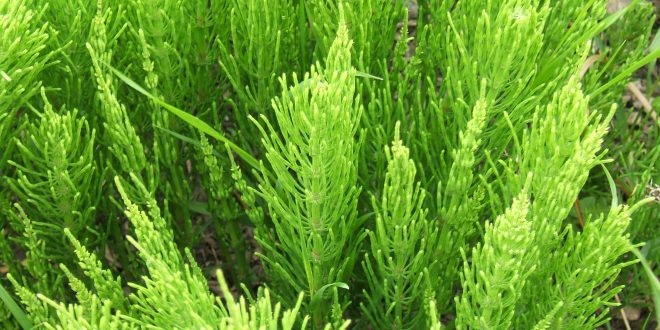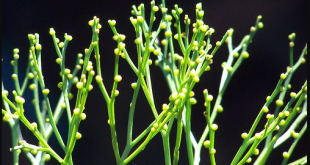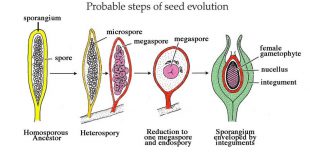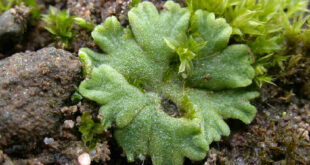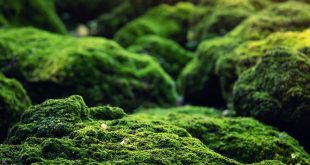Equisetum: The Scouring Rushes
Equisetum commonly known as ‘Horsetails’ or ‘Scouring rushes’. It comprises about 25 species and is worldwide in distribution. Except This genus in vascular plants, there is no living genus in Equisetaceae family that reproduces by spores rather than seeds.
Taxonomic position:
Division: Sphenophyta
Class: Sphenopsida
Order: Equisitales
Family: Equisitaceae
Genus: Equisetum
Distribution and Habitat
The majority of the species are small around 15 ∼ 60 cm in height and 2.0 cm in diameter. It can grow in a wide variety of habitats and absorbs silica. Some species grow in damps and shaded places, others grow in ponds and marshes or in sandy soil, near the banks of rivers, etc. Some of the common species of Equisetum are- E. debile, E. arvense, E. elongatum etc.
The aerial part is herbaceous and usually annual. Though some species are thin (0.5∼2.0 cm) They can be tall in heights [e.g., E. giganteum (13 m), E. telmateia (2 m); E. ramosissimum (4 m). Some of them live as a climber. According to Encyclopedia of Flora and Fauna of Bangladesh, only two members of Equisetum (i.e., E. Diffusum , E. Ramosissium subsp. Debile) are enlisted.
Best safe and secure cloud storage with password protection
Get Envato Elements, Prime Video, Hotstar and Netflix For Free
Best Money Earning Website 100$ Day
#1 Top ranking article submission website
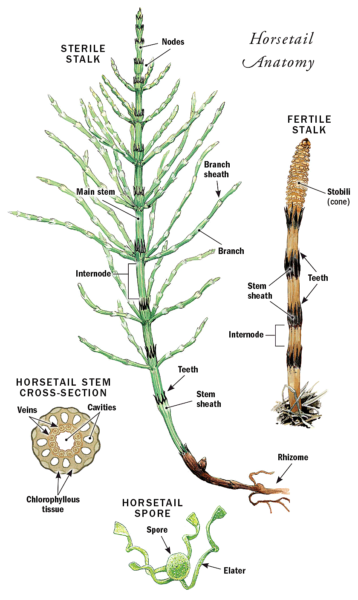
External features
- Plant body is well-branched, differentiated into root, stem, and leaf.
- Stem has distinct nodes and internodes.
- The portion between two nodes called internodes.
- At the point of the node, some erect branches develop and turn into 2 types of branches- i) fertile branch and ii) sterile branch.
- The node is covered by a whorl of scale leaves.
- At the point of nodes, numerous roots are developed.
- Many round tubers are produced from roots.
Internal features of Equisetum
In this section, we will discuss about the internal morphology of the plant body.
T. S. of stem
- Shows a wavy outline with prominent ridge and furrows.
- The outermost layer is epidermis which is cuticularized. Silica may be deposited in the epidermis and gives a very rough surface. For this reason, the stems may be used to scour pots, metals, etc and commonly known as ‘Scouring rushes’.
- The epidermis is followed by a broad cortex.
- Under each ridge, there is a strand of sclerenchyma, the remaining peripheral portion of cortex is made up of chlorenchyma.
- Below the furrows, large intercellular space may be found which is called the ‘Vallecular canal’.
- The next layer of the cortex is endodermis, at the center pith is present.
- In between pith and endodermis, vascular bundle present.
- In the mature Vascular bundle, the xylem and tracheid become disorganized to form a cavity called ‘Carinal canal’.
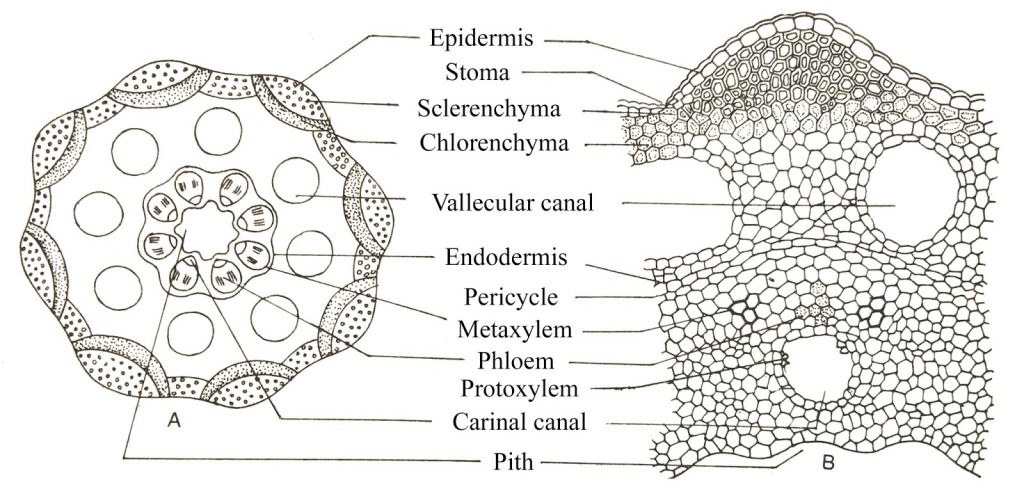
T.S. of root
- The outermost layer is the epidermis, from which arise many root hairs.
- Cortex is thick and multi-layered.
- Endodermis is two-layered.
- Stele is a protostele.
- In the center, a large metaxylem is present and protoxylem towards the periphery.
- In between the angles of protoxylem, phloem is present.
Reproduction of Equisetum
According to their mode of reproduction are mainly 3 types:
- Vegetative reproduction
- Asexual reproduction
- Sexual reproduction
A. Vegetative reproduction
By means of tubers. Ovoid shaped tuber found in E. arvense and pear-shaped in E. telmateia.
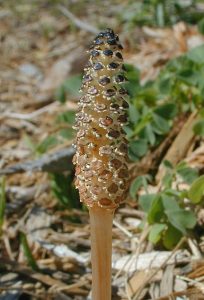
B. Asexual reproduction
Equisetum carry out the asexul reproduction by spores. These spores are produced from cone or sporangiferous spike. The strobilus are formed 0n the chlorophyllous vegetative shoot.
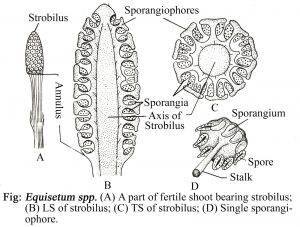
C. Sexual reproduction
During Equisetum’s gametophytic stage, There are male sex organs antheridium and female sex organ archegonium produced. Equisetum usually has both male and female sex organs (Bisexual). But, some unisexual members are also present in this genus. After maturation of the archegonium and antheridium fertilization happens. As the motile antherozoides have to swim to reach to the archegonia, water is essential for fertilisation. As a result, newly formed embryo will start a new sporophytic generation.
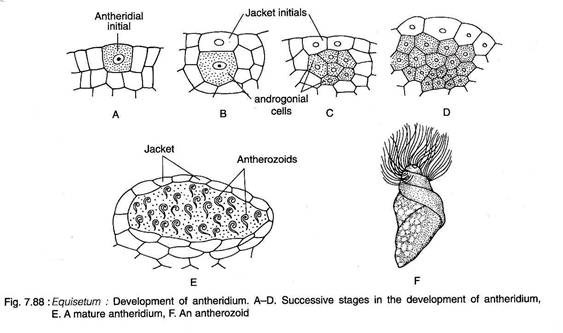
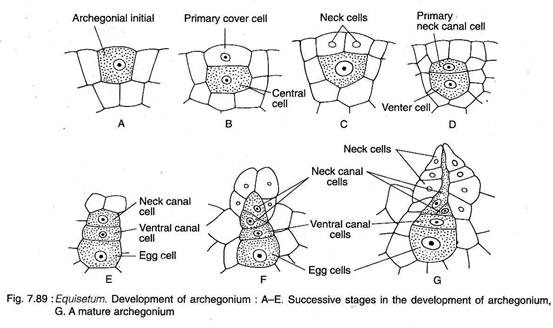
Life Cycle of Equisetum
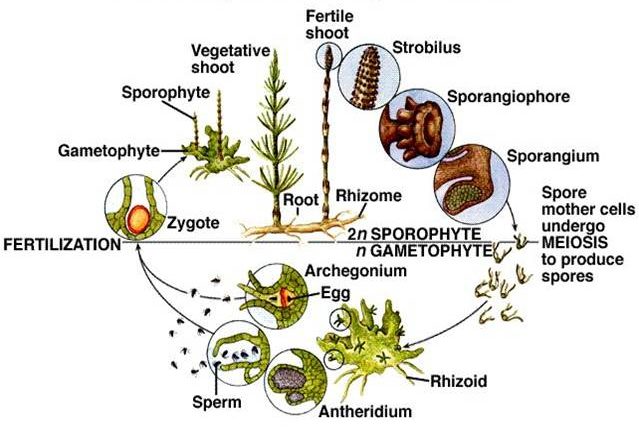
 Plantlet The Blogging Platform of Department of Botany, University of Dhaka
Plantlet The Blogging Platform of Department of Botany, University of Dhaka
